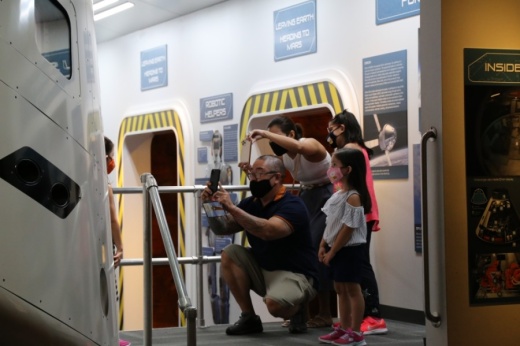While there is no data yet available of how the museum’s closure and limited capacity has affected nearby restaurant visits and hotel stays, the effect is apparent, Moore said.
“They come down here and they put heads in beds, and they dine and whatnot, and with [COVID-19], things have definitely been reduced,” she said.
In 2018, for the first time, Space Center Houston surpassed 1 million annual visitors. In 2019, over 1.28 million visited the museum, in part due to the large celebration Space Center Houston held for the 50th anniversary of Apollo 11, the first time humans landed on the moon, museum CEO William Harris said.
“What attracts visitors here is you get to see where astronauts train. You see real space hardware,” he said. “And space is one of the great frontiers in human imagination.”
In 2019, Quanticon, independent researchers from University of Houston-Clear Lake, released a report detailing the museum’s 2018 economic effects on the area.
The report states the museum has a $118.7 million impact on the area’s economy, including $84.7 million on the tourism industry, $18.9 million on local restaurants and $11.1 million on hotels with over 94,100 annual hotel stays attributable to the museum. Additionally, over 1,700 jobs are attributable to Space Center Houston, and it generates $3.5 million in tax revenue for state and local governments, according to the report.
“Space Center Houston helps drive home the reality that Clear Lake has become one of the Houston region’s key tourism meccas,” said Dan Seal, executive director of economic development for Bay Area Houston Economic Partnership. “It’s a cool factor that other cities just don’t have, and we’re proud of that, and we sell that as part of the Bay Area Houston experience.”
Quanticon also released an economic study for the museum in 2015. The 2019 report showed a 63% increase in total economic impact and an 85% increase in local area jobs compared to the 2015 study.
“That’s pretty dramatic growth in four years’ time,” Harris said.
Seal said before the pandemic, the Bay Area had seen in the last three to five years a boom in hotel activity, at least part of which can be attributed to Space Center Houston’s growing popularity.
“It’s very important to our area, and we’re so fortunate to have it,” Seal said.
Before COVID-19, the museum was projecting over 1.2 million visitors for 2020. Up until March, Space Center Houston was on track to have its best year of attendance yet, but the pandemic nixed those plans.
As of Oct. 3, the museum had seen 264,668 visitors this year, 92% of which are from the United States. That is 30% of the number of visitors museum officials had projected before the pandemic to have by that time for 2020, Moore said.
However, the center is used to plateaus. Attendance dropped off in 2017, when Hurricane Harvey hit, and in 2011, the year of NASA’s last shuttle mission. The coronavirus pandemic is no different, and the museum’s goal is still to reach 2 million annual visitors, Harris said.





